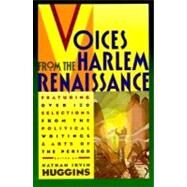Voices from the Harlem Renaissance
, by Huggins, Nathan Irvin- ISBN: 9780195093605 | 0195093607
- Cover: Paperback
- Copyright: 1/26/1995
The Harlem Renaissance of the 1920s symbolized black liberation and sophistication--the final shaking off of slavery, in the mind, spirit, and character of African-Americans. It was a period when the African-American came of age, with the clearest expression of this transformation visible inthe remarkable outpouring of literature, art, and music. In these years the "New Negro" was born, as seen in the shift of black leadership from Booker T. Washington to that of W.E.B. Du Bois, from Tuskegee to New York, and for some, even to the African nationalism of Marcus Garvey. In Voices from the Harlem Renaissance, Nathan Irvin Huggins provides more than 120 selections from the political writings and arts of the period, each depicting the meaning of blackness and the nature of African-American art and its relation to social statement. Through these pieces, Hugginsestablishes the context in which the art of Harlem Renaissance occurred. We read the call to action by pre-Renaissance black spokesmen, such as A. Philip Randolph and W.E.B. DuBois who--through magazines such as The Messenger ("the only radical Negro magazine"), and the NAACP's Crisis--called for aradical transformation of the American economic and social order so as to make a fair world for black men and women. We hear the more flamboyant rhetoric of Marcus Garvey, who rejected the idea of social equality for a completely separate African social order. And we meet Alain Locke, whose workserved to redefine the "New Negro" in cultural terms, and stands as the cornerstone of the Harlem Renaissance. Huggins goes on to offer autobiographical writings, poetry, and stories of such men and women as Langston Hughes, Nancy Cunard, Helen Johnson, and Claude McKay--writings that depict the impact of Harlem and New York City on those who lived there, as well as the youthfulness and exuberance of theperiod. The complex question of identity, a very important part of the thought and expression of the Harlem Renaissance, is addressed in work's such as Jean Toomer's Bona and Paul and Zora Neale Hurston's Sweat. And Huggins goes on to attend to the voices of alienation, anger, and rage that appearedin a great deal of the writing to come out of the Harlem Renaissance by poets such as George S. Schuyler and Gwendolyn Bennett. Also included are over twenty illustrations by such artists as Aaron Douglas whose designs illuminated many of the works we associate with the Harlem Renaissance: themagazines Fire and Harlem; Alain Locke's The New Negro; and James Weldon Johnson's God's Trombones. The vitality of the Harlem Renaissance served as a generative force for all New York--and the nation. Offering all those interested in the evolution of African-American consciousness and art a link to this glorious time, Voices from the Harlem Renaissance illuminates the African-American strugglefor self-realization.







